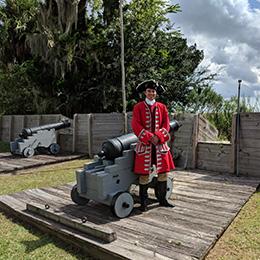» Pet Notice:
› Leashed pets are allowed on historic site trails, however, they are not allowed in buildings. Please view our Park Rules page for more information.
Visitors to Fort Morris State Historic Site can the hear whispers of the past as they gaze into the panoramic vista of the coastal environment while traversing the well preserved original earthworks that served as a bastion of liberty and defiance while defending the commercial seaport of Sunbury and the strategic Medway River during the American Revolution and War of 1812.
When the Continental Congress convened in 1776, the delegates recognized the importance of a fort to protect their growing seaport from the British. Soon afterwards, a low bluff on the Medway River at Sunbury was fortified and garrisoned by 200 patriots. When the British demanded the fort’s surrender on November 25, 1778, the defiant Col. John McIntosh replied, “Come and take it!” The British refused and withdrew back to Florida. Forty-five days later, they returned with a superior force, and on January 9, 1779, Fort Morris fell after a short but heavy bombardment.
Under the name of Fort Defiance, this bulwark was once again used against the British during the War of 1812, and Sunbury's harbor was guarded by armed barges. Today, visitors can stand within the earthwork remains and view scenic Saint Catherines Sound. A museum and film describe the colonial port of Sunbury and the site’s history.
Visitors may borrow binoculars and a field guide to go birding. Downy woodpeckers, pileated woodpeckers, goldfinches, wood storks, painted buntings, great egrets and many other coastal species can be seen.
Facilities
- 66 Acres
- Visitor Center
- Gift Shop
- Picnic Area
- Bus Parking
- Pioneer Campsite
Things To Do & See
- Educational Programs
- Nature Trail
- Picnicking
- Birding — Colonial Coast Birding Trail
Nearby Attractions
- Golden Isles of Georgia
- Fort King George State Historic Site
- Fort McAllister State Park
- Hofwyl-Broadfield Plantation State Historic Site
- Midway Museum
- Richmond Hill, GA
- Reynolds Mansion on Sapelo Island
- Savannah, GA
- Skidaway Island State Park
- Wormsloe State Historic Site
- Richmond Hill WMA
- Townsend WMA















